
Disruption In The Library
Posted on Dec 23, 2016 by Julian Mitchell
We talked to Sebastian Jaeger from Filmstro, whose fascinating music library software defies categorising and will make composers of us all.
Filmstro is a unique audio software product so bear with me. It presents pieces of music and allows you, the composer or user – you don’t need to be musical, only creative – to power your video’s narrative through what have been analysed to be the three constants in music structure: momentum, depth and power. You manipulate these three parameters to suit the video. It’s like library music that lives.
A set of three software sliders allows you to do this and as you do, it writes key frames which are ultimately editable. Five minutes with the software will explain more than words can so Windows and Mac users should go to filmstro.com and download the demo. It is remarkable.
But where has Filmstro come from, who is it for and is it dumbing down? Sebastian Jaeger, musical director and co-founder of Filmstro, is a music composer and music producer by trade, spent a few years composing and producing mostly for advertising. “I worked for creative agencies in Soho, advertisers and so on. Working with the type of tools that someone who works with creative media does was obviously an inspiration for Filmstro. I was hard pressed to call it working really, you’re playing with all these cool software instruments and recording musicians every now and again making lovely tracks. Also working in advertising you can’t escape the fact that it’s essentially frivolous!”
A more recognisable inspiration for the product came from Apple’s market-leading Logic Pro X music software. “That had a really cool new plug-in, which came as standard, the ‘drummer’ plug-in. So with a very simple X-Y pad people could choose between ‘upfront and busy’ and ‘laid-back and quiet’, that kind of thing. It did switch a light bulb on and I thought that’s genius, if you could do that for a whole orchestra effectively and give ordinary people the chance to manipulate music in a really simple and intuitive way, that would be pretty special.”
 Sebastian Jaeger
Sebastian Jaeger
Communicating
“That dovetailed with something else I’d been working on which was a much more academic and abstract kind of thing, which was basically some way to communicate with people in the creative media world about music but using their terminology. Talking about music is incredibly difficult and subjective and so I had this idea of splitting out a piece of music in to different elements and I had labelled those elements using visual arts terminology. Things like ‘canvas’, ‘outline’, ‘colour’ and ‘shading’. I ran it past a bunch of people and one of the early pieces of feedback was, ‘this is fine but you got to make it way simpler’.
“I tried to write a piece of music that was broken down into seven things and it was fine, it worked but it was just going to be too much work. It took a long time, but eventually we came up with something that is so obvious, that is the three parameters we now use. You can break any piece of music into basically ‘momentum’, ‘depth’ and ‘power’.
“We had developed Filmstro initially for the iPad, which, of course, allows you to control three sliders at the same time with your fingers. So we brought over the slider idea because of that and stayed with it. The happy accident was actually ending up with the graph editor where you can see the music. That was really exciting. I knew we could do something where we could maybe see the music after we created it, but my co-founder said there was no reason why we couldn’t do some real time. People should be able to ride the sliders and that should literally be generating the points on the graph editor, much like volume automation inside a digital workstation. That’s a really good feature; as a visual person you go into the graph editor and literally key frame the action while scrubbing through your edit and visually marking to yourself: ‘Here I want high momentum and here I want it to be low powered etc…’ and key framing the music to change.
“Or you could be more like me, a more auditory person. I would actually watch the edit and literally just drive the sliders in real time like an audio engineer on a mixing desk, driving the faders up and down creating those key frames in real time.
“Whichever way you create it, you can go back and physically interact with it both ways, you can individually highlight and select multiple or individual key frames and move them or delete them or redo them, or you can go back to the sliders and at any point start the play head again and literally redo a slider movement to make it better, which will overwrite what you had; you can ‘save as’ to keep what you had.”
Filmstro is at the point of major lift-off as a product. They are working to create a single code base for Windows and Mac and when that is done, there are at least 150 additional functionality tweaks and improvements waiting in the wings. Things like the ability to add musical endings is a huge one because at the moment the music is essentially looping and you can only create a fade-out. The other one sounds boring but is really fundamental.
At the moment within the app, if you trim a region, the visual representation of the music which sits in the timeline underneath the video, from the left, you’re actually not trimming it, you’re not cutting into it at all, you’re actually only moving the start point. Really what ought to be happening when you trim from the left is, it should leave the music where it is and you just trim into it from the left leaving your sync points in place. A major upgrade for search is also on the cards.








